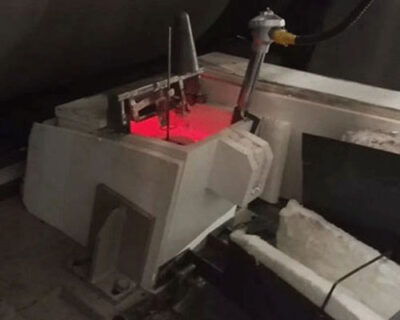Molten metal flow controllers may be used in conjunction with nozzle and tip, and wherein the tip has sides which are substantially straight sides, which preferably are diverging. In addition, molten metal flow controllers may be used in conjunction with sidewalls, and wherein the top and bottom walls are substantially straight, but diverging after flow controllers. Providing uniform velocity and thermal profile utilizing the molten metal flow controllers has the advantage of producing slab stock, particularly aluminum slab stock substantially free of surface streaking or surface defects.
The material for fabrication of nozzle tip is a material suitable for contacting molten metal, and which material is resistant to dissolution or erosion by the molten metal.
The level of molten metal in the reservoir is maintained by metal level control through which molten metal flows via spout from the molten metal source. Metal level control controls the flow rate of metal into the reservoir using a float to determine and control the level of molten metal in the reservoir.

Tip member serves to supply a flow of molten metal from the reservoir to the nip of a pair of rollers and. This flow of a ribbon of molten metal should be of uniform velocity and temperature distribution across the entire width of the tip member which may vary commercially from as little as 36 inches to as much as 60 inches or more. Maintaining such uniform metal flow and temperature characteristics for widths of 60 inches or more have been unattainable in the prior art.
Tip member comprises a top wall and a bottom wall supported by tip clamp members. The top wall and bottom wall are joined together by side riser members and to define a passageway. By making side riser members convergent, flow separation and reverse flow will be eliminated near the side riser member. The convergent channel formed thereby provides a favorable pressure gradient along the walls and an accelerating main flow which limits the boundary layer thickness growth of the flowing metal downstream. This eliminates to a minimum, one cause of nonuniformity in the metal flow velocity found in the prior art.

